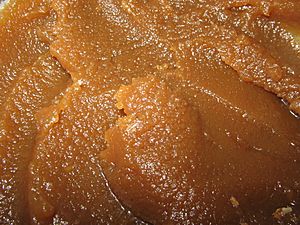Coconut jam facts for kids

A jar of matamís sa báo from the Philippines
|
|
| Alternative names | |
|---|---|
| Type | Spread, Dip |
| Region or state | Maritime Southeast Asia |
| Associated national cuisine | Singapore, Malaysia, Indonesia, Brunei, Philippines, and Thailand |
| Main ingredients | Coconut, sugar, eggs |
Coconut jam, also known as kaya jam or simply kaya, is a yummy, sweet spread. It's made from coconut milk, eggs, and sugar. This tasty jam is very popular across many countries in Southeast Asia.
Contents
What is Kaya Jam?

The word "kaya" in the Malay language means "rich." This describes the smooth, creamy texture of this popular food. For people in Malaysia, Indonesia, and Singapore, kaya is a sweet coconut spread. It's made from coconut milk (called santan) and duck or chicken eggs. To make it extra special, pandan leaves are added for flavor. Sugar makes it sweet.
The color of kaya can be different. It depends on the color of the egg yolks used. It also depends on how much pandan is added. Sometimes, the sugar is caramelized, which makes the jam darker.
How is Coconut Jam Eaten?
Kaya is a very popular local spread. People usually put it on toast to make kaya toast. It's often eaten for breakfast. But you can enjoy it any time of the day! You can find kaya in most kopitiams (traditional coffee shops) and night markets.
There are different kinds of kaya. Nyonya kaya is a lighter green color. Hainanese kaya is darker brown. It uses caramelized sugar and sometimes honey for extra sweetness.
In Singapore, Malaysia, and Indonesia, kaya is also used in desserts. For example, it's a topping for pulut taitai. This dessert is made of sweet glutinous rice colored blue with butterfly pea flowers. Another similar dessert is pulut seri muka. This one is green because of pandan leaves. Kaya is also used with glutinous rice to make kuih seri kaya.
Coconut Jam in the Philippines
In the Philippines, coconut jam is called matamís sa báo. This name means "sweetened coconut." The Philippine version is a bit different from other Southeast Asian jams. It uses thick coconut cream (called kakang gata). It also uses cane sugar extract or molasses.
A big difference is that Philippine coconut jam does not use eggs. This makes it more like a syrup than a custard. People often eat it on toast or a type of bread called pandesal. It's also used as a filling for pan de coco, a sweet bread roll. When mixed with ground glutinous rice paste, it becomes a dessert called kalamay.
A thinner version of this jam is called latik. It's like a coconut caramel. Latik is used instead of syrup in many Filipino desserts.
Coconut Jam in Thailand
In Thailand, coconut jam is called sangkhaya (Thai: สังขยา). There are two main types of sangkhaya in Thailand.
One type is thinner, similar to the jam eaten in Malaysia and Indonesia. People spread it on steamed or toasted bread. Or they might dip their bread right into the sangkhaya. You can often buy this kind of sangkhaya from street vendors. Recently, it has also become popular in tea and coffee shops.
The other type of sangkhaya is thicker. It has a texture more like a custard. Sometimes, it's called "coconut custard" in English. This custard is used to make delicious desserts like sangkhaya fakthong. This is a sangkhaya served inside a pumpkin. Another popular dish is khao niao sangkhaya, which is glutinous rice topped with sangkhaya. There's also sangkhaya maphrao, which is sangkhaya served in a coconut.
See also
 In Spanish: Mermelada de coco para niños
In Spanish: Mermelada de coco para niños

